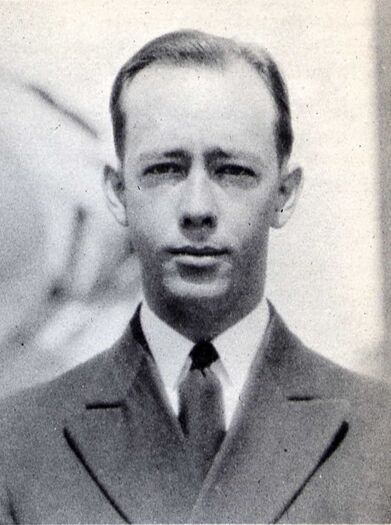THOMAS V. PETERS, LT, USN
Thomas Peters '33
Lucky Bag
From the 1933 Lucky Bag:
THOMAS VIDETTE PETERS
Minatare, Nebraska
"Pete" "Tom"
Four years ago to two-gun Pete the North Platte was a mighty barrier. But in the memorable rush of 1919 (eight Nebraska men entered the Academy that year) Pete heard the call "Come East, young man," packed his bag, left his little grey home in the West midst the sand hills of the Sioux country and headed toward the rising sun.
Today that bold, bad man is no more. The influences of travel and the Navy have done their "derndest." He no longer has coyotes and wolves for pals, no longer yearns for saddle and spur, but for wine, women, and the movies, the latter being his greatest weakness; he no longer likes to talk with the stars, but now curses them for the work they make for him. But certain Western traits linger with him still. He is a "big shot" with the women, and true to his memory of the pony stages he was a member of the Stage Gang.
But seriously, behold the man; first a gentleman of the finest sense; intelligent, but honest; energetic and quick to make friends and keep them. Pete will make a good officer in any man's navy. Good luck to you, pal!
Stage Gang 4, 3, 2, 1; 2 P. O.

THOMAS VIDETTE PETERS
Minatare, Nebraska
"Pete" "Tom"
Four years ago to two-gun Pete the North Platte was a mighty barrier. But in the memorable rush of 1919 (eight Nebraska men entered the Academy that year) Pete heard the call "Come East, young man," packed his bag, left his little grey home in the West midst the sand hills of the Sioux country and headed toward the rising sun.
Today that bold, bad man is no more. The influences of travel and the Navy have done their "derndest." He no longer has coyotes and wolves for pals, no longer yearns for saddle and spur, but for wine, women, and the movies, the latter being his greatest weakness; he no longer likes to talk with the stars, but now curses them for the work they make for him. But certain Western traits linger with him still. He is a "big shot" with the women, and true to his memory of the pony stages he was a member of the Stage Gang.
But seriously, behold the man; first a gentleman of the finest sense; intelligent, but honest; energetic and quick to make friends and keep them. Pete will make a good officer in any man's navy. Good luck to you, pal!
Stage Gang 4, 3, 2, 1; 2 P. O.
Loss
Thomas was lost on January 25, 1942 when USS S-26 (SS 131) sank following a collision with USS Sturdy (PC 460) near Panama.
Other Information
From researcher Kathy Franz:
Thomas attended Minatare and Melbeta schools and graduated in 1927 from a high school at Whitney, Nebraska. He attended Hastings college his freshman year and transferred to Chadron his sophomore year where he was elected secretaryship of the Delta Pi Sigma fraternity.
Congressman Robert G. Simmons named Thomas to the Naval Academy in June 1929.
On June 18, 1935, Thomas married Adeline Piersoll in the Rectory of Saint Matthew’s Roman Catholic Church in Long Beach, California.
In September 1937, Thomas’ submarine squadron reached Manila from China. The squadron was based at Tsingtao, China, during the summer. His wife was with him in both places.
Thomas was promoted to lieutenant in February 1940.
During his lifetime, Thomas’ father was a public school teacher, a superintendent, and justice of the peace. He also was very involved in Red Cross work.
From the 1953 edition of the book "Double Three Roundup," published by the class of 1933:
Upon graduation Tommy reported to the NEVADA. In 1935 he entered the pleasant state of matrimony accompanied by Adeline Pierceall of Long Beach, California. The same year he was ordered to the Staff of Commander Battleship Division 2, serving under Admiral Pettengill in the ARIZONA. A year later he decided to try for a more independent type of duty in which greater responsibility came sooner to a junior officer. He volunteered for submarine duty and upon completing the course of instruction was ordered to the S-41 which was then operating with the Asiatic Fleet in the China area. In 1939 he returned to the U.S. to join the New London Indians as an officer in the R-11.
On June 13, 1940 Tommy recommissioned the S-26 as executive officer and after a period in New London sailed to the Canal Zone. The S-26 was sunk in a collision with an escorting converted yacht while proceeding on the surface on the night of January 24, 1942 off Panama. Only three of the S-26's personnel, who were on the bridge were saved. Tommy was one of those trapped below. The disaster occurred while the S-26 was proceeding from Balboa to it's patrol station in company with the S-21, S-29, and S-44 and escort vessel PC-460. At 2210 the escort vessel sent a visual message to the submarines that she was leaving formation and that they could proceed to the duty assigned. S-21 was the only submarine to receive this message. Shortly thereafter, the PC-460 struck the S-26 on the starboard side of the torpedo room and the submarine sank within a few seconds. Salvage operations were started immediately and attempts at rescue were made but without success. The submarine was not raised. She had previously made one war patrol but had inflicted no damage on the enemy.
Tommy is survived by his widow, who is now married to Lieutenant Commander Carl B. Hibben, and by his parents, Mr. and Mrs. E. T. Peters of Minitare, Nebraska.
From the Minatare Free Press on February 12, 1942:
Thomas Videtto Peters was born in the Videtto home near Minatare, August 6, 1909, and lived in South Dakota during the first seven years of his life. His parents then moved back to the vicinity of Minatare and Tom received his elementary education in the Minatare and Melbeta schools. He united with the local Methodist church at ten years of age. He entered high school at Whitney, Nebraska, in 1923, and was graduated in 1927. In the fall of that year he entered Hastings college for the freshman year, but took his second year of college work at Chadron Normal college. During this second year of college work Congressman Robert G. Simmons named him for appointment to the United States Naval Academy at Annapolis, Maryland, where he was accepted in June 1929. While in the academy his class was sent on two extended summer cruises, on the first of which the middies were taken to Europe abroad three battleships, one of which was the Arizona, recently destroyed by the Japs in Pearl Harbor. During this cruise considerable time was spent in France, Norway, Germany and Scotland. The second cruise, two years later, took them to the Azores, Canada and other points.
Tom was graduated from the academy in 1933 and sent to the west coast, where he served for two years on the battleship Nevada. He was then transferred to the staff of Admiral Pettingille, commander of a battleship division of which the Arizona was the flagship. In June 1935, Tom was married to Miss Adeline Elizabeth Pierceall of Long Beach, California, and in the same year was promoted to Lieutenant J. G.
The young lieutenant was anxious to get into submarine and was recommended by Admiral Pettingille for training at the submarine school at New London, Connecticut, where he entered in June, 1936. This training was finished the following December and he, with his wife, went at once to the Far East, where he was in submarine, being based at Tsingtao, China, and at Manila, Philippine Islands. This duty ended, the couple returned to the United States and Tom was transferred at once to the Atlantic submarine base at New London. Enroute to this assignment Tom and his wife arrived in Minatare on the day following the death of his grandfather, S. S. Videtto, in September, 1939.
From this time on Tom was based at New London and was promoted to lieutenant in 1941. His submarine left the base under sealed orders December 10, after the attack on Pearl Harbor. His relatives have not known just where he was until the navy department released the information on February 5th that he had lost his life in line of duty on January 25. Later, information was released to the effect that the submarine S-26, of which he was second in command, sank as a result of a collision while running without lights during night maneuvers at the Pacific end of the Panama Canal. All members of the crew except three who were on the bridge at the time of the collision were lost. The near relatives of Thomas Videtto Peters left to mourn his loss are his wife, Adeline, now at Parsons, Kansas; his parents, Elmer T. and Mrs. Peters, and grandmother, Mrs. Lucy Videtto of Minatare, and two aunts and their families, Mrs. Dr. Plehn of Scottsbluff, and Mrs. Eva Gross of Monroe, Louisiana.
His wife was listed as next of kin. He has a memory marker in Nebraska.
Photographs
Career
From the now-broken link http://www.fleetorganization.com/subcommandersclassyear3.html:
- Executive Officer USS S-41 (SS-146) 1 Apr 1939 - 1 Jul 1939
- Duty Submarine Squadron Five 1 Jul 1939
- Duty USS R-11 (SS-88) 1 Oct 1939
- Executive Officer USS S-26 (SS-131) 1940 - Jan 1942
- Acting Captain USS S-26 (SS-131) 31 Dec 1940 and 31 Oct 1941
- Lieutenant (j.g.) 1 Jun 1936
- Lieutenant 1 Apr 1941
The "Register of Commissioned and Warrant Officers of the United States Navy and Marine Corps" was published annually from 1815 through at least the 1970s; it provided rank, command or station, and occasionally billet until the beginning of World War II when command/station was no longer included. Scanned copies were reviewed and data entered from the mid-1840s through 1922, when more-frequent Navy Directories were available.
The Navy Directory was a publication that provided information on the command, billet, and rank of every active and retired naval officer. Single editions have been found online from January 1915 and March 1918, and then from three to six editions per year from 1923 through 1940; the final edition is from April 1941.
The entries in both series of documents are sometimes cryptic and confusing. They are often inconsistent, even within an edition, with the name of commands; this is especially true for aviation squadrons in the 1920s and early 1930s.
Alumni listed at the same command may or may not have had significant interactions; they could have shared a stateroom or workspace, stood many hours of watch together… or, especially at the larger commands, they might not have known each other at all. The information provides the opportunity to draw connections that are otherwise invisible, though, and gives a fuller view of the professional experiences of these alumni in Memorial Hall.
July 1933
October 1933
April 1934
July 1934
October 1934
January 1935
April 1935
October 1935
LTjg Robert Vandling '32 (USS Arizona)
ENS Charles Brewer '34 (USS Arizona)
January 1936
LTjg Robert Vandling '32 (USS Arizona)
ENS Charles Brewer '34 (USS Arizona)
April 1936
LTjg Robert Vandling '32 (USS Arizona)
ENS Charles Brewer '34 (USS Arizona)
July 1936
January 1937
April 1937
July 1938
January 1939
October 1939
June 1940
November 1940
April 1941

The "category" links below lead to lists of related Honorees; use them to explore further the service and sacrifice of alumni in Memorial Hall.
